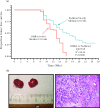Data-Driven identification of chemopreventive agents for breast cancer
- PMID: 32233182
- PMCID: PMC7672343
- DOI: 10.3906/sag-2003-138
Data-Driven identification of chemopreventive agents for breast cancer
Abstract
Preclinical animal models of breast cancer provide the opportunity to identify chemopreventive drugs with single-agent activity as well as effective multi-modality regimens for primary as well as secondary prevention in high-risk persons. Our group has used the 7,12-dimethylbenz(a)anthracene (DMBA) mouse model of carcinogen-induced breast cancer to explore the clinical potential of two tyrosine kinase inhibitors and a nucleoside analog as chemopreventive agents. All three agents exhibited promising preclinical activity both as monotherapy and as components of combination therapy with the standard chemotherapy drug paclitaxel. The tumors developing despite chemoprevention were not only small and grew slowly, but they also displayed a uniquely more pro-apoptotic protein expression profile. Hence, our experimental chemopreventive drugs were capable of preventing the development of aggressive mammary gland tumors with an apoptosis-resistant protein expression profile.
Keywords: Breast cancer; LFM-A13; WHI-P131; stampidine.
This work is licensed under a Creative Commons Attribution 4.0 International License.
Conflict of interest statement
The authors declare no conflict of interest.
Figures




References
-
- Siegel RL Miller KD Jemal A Cancer Journal for Clinicians . 2019;69:7–34. - PubMed
-
- Bozovic-Spasojevic I Azambuja E McCaskill-Stevens W Dinh P Cardoso F Chemoprevention for breast cancer. Cancer Treatment Reviews . 2012;38:329–339. - PubMed
-
- Cuzick J Powles T Veronesi U Forbes J Edwards R Overview of the main outcomes in breast-cancer prevention trials. The Lancet . 2003;361:296–300. - PubMed
Publication types
MeSH terms
Substances
LinkOut - more resources
Full Text Sources

